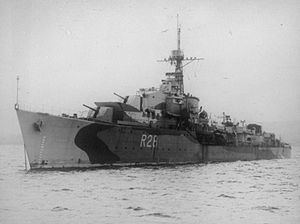Name HMS Verulam Laid down 26 June 1942 Decommissioned 1970 Construction started 26 June 1942 Length 111 m | Ordered 1 September 1941 Commissioned 12 December 1943 Launched 22 April 1943 | |
 | ||
HMS Verulam was an V-class destroyer of the British Royal Navy that saw service during the Second World War.
Contents
Second World War service
HMS Verulam began her service in late 1943 by joining the 26th Destroyer Flotilla, part of the Home Fleet, stationed in the North Atlantic. The flotilla was supported by the depot ship, HMS Tyne. The flotilla's first role during 'work up' was to participate in an offensive patrol of the Norwegian coast.
In February 1944, the flotilla then escorted convoy RA56 returning from Murmansk. The same month HMS Verulam and the flotilla was part of the escort group attached to convoy JW57 along with the light cruiser, HMS Black Prince and the escort carrier, HMS Chaser. On the 28th February the convoy reached the Kola Inlet with the loss of one destroyer, HMS Mahratta and the destruction of two U-boats. She returned with the escort group as part of convoy RA57, arriving at Loch Ewe on 7th March 1944.
In April 1944, the 26th Destroyer Flotilla took part in Operation Tungsten; the attack on the German battleship Tirpitz and the distant cover of the convoy JW58 which was bound for the Kola Inlet. On 28th April, Verulam embarked seventeen personnel and joined convoy RA59; returning to home waters on the 3rd May.
During May 1944, Verulam participated in preparations for Operation Neptune as part of Force S. The following month, on 5th June, she entered the Solent and began her part in the Normandy landings; bombarding targets around Lion-sur-Mer on 6th June.
She participated in the Battle of the Malacca Strait with the destroyers Saumarez, Venus, Vigilant, and Virago which culminated in the sinking of the Japanese cruiser Haguro on 16th May 1945.
Postwar service
In 1946 Verulam was part of the Londonderry Flotilla. Between February 1947 and March 1949 she was part of the 3rd Destroyer Flotilla, based in the Mediterranean. During that time she saw service, along with other Royal Navy ships in preventing illegal immigration into Palestine in 1947.
Between 1951 and 1952 she was converted into a Type 15 fast anti-submarine frigate at Portsmouth Dockyard, and was allocated the new pennant number F29. In 1953 she took part in the Fleet Review to celebrate the Coronation of Queen Elizabeth II. In 1954 Verulam was placed in the Portsmouth Reserve.
Between 1958 and 1961 she was the Admiralty Surface Weapons Establishment (ASWE) trials ship. In 1961 she was the 2nd Frigate Squadron Portland Trials ship for the Underwater Weapons Development establishment (UWDE).
Decommissioning and disposal
Verulam was paid off on 21st December 1970 and sold for scrap to John Cashmore Ltd and arrived at their yard at Newport, Wales for breaking on 23rd October 1972.
